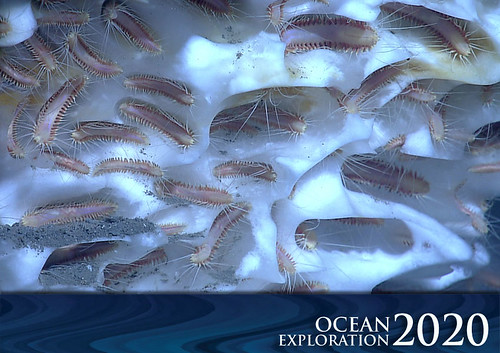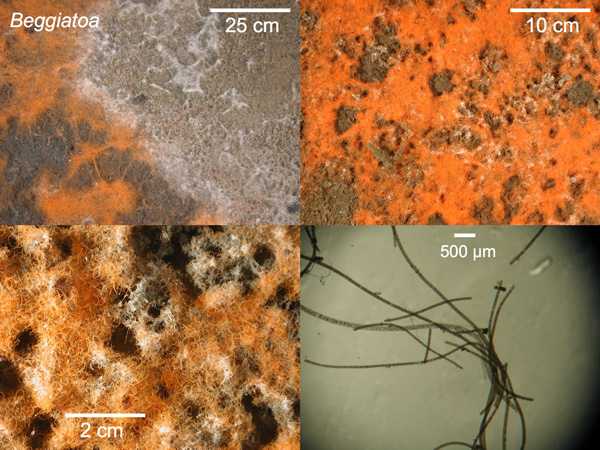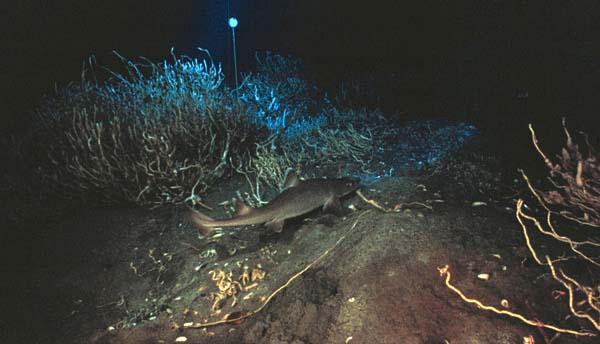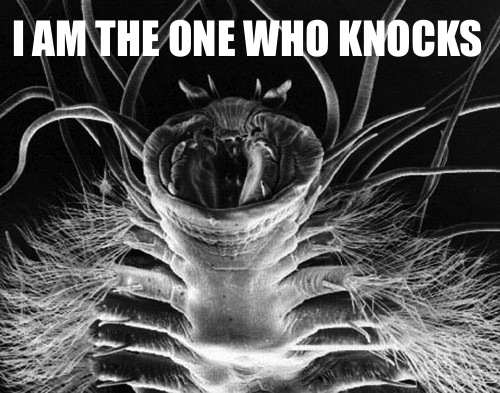The post Top 10 Reasons I Love Crystal Meth(ane) first appeared on Deep Sea News.
]]>Yo Bitch, let’s talk about cold seeps!
10. Blue Ice
You don’t need to track down Walter and Jesse to get your hands on some sweet blue ice. You can find Crystal Meth(ane) at the bottom of the ocean: high pressure and cold temperatures lead to the formation of gas deposits known as Methane Hydrates, where “molecules of natural gas are trapped in an ice-like case of water molecules”. These deposits look a little something like this:

Instead of scattered chunks you can also find HUGE blocks of Crystal Meth(ane). This is the largest one ever recorded in the Gulf of Mexico, measuring in at a whopping 6 metres wide x 2 metres high x 1.5 meters deep!

9. Crack dens
I’m talking about the fissures in the seafloor – cold seeps are literal crack dens. Where do you think all that Meth(ane) comes from? It slowly seeps out of the seafloor!
Cold seeps occur over fissures on the seafloor caused by tectonic activity. Oil and methane “seep” out of those fissures, get diffused by sediment, and emerge over an area several hundred meters wide. Methane is the main component of what we commonly refer to as natural gas. But in addition to being an important energy source for humans, methane also forms the basis of a cold seep ecosystem. (NOAA Ocean Explorer)
This crab is a total junkie, so don’t mess with him – and definitely don’t laugh when he gets Meth(ane) all over his face!
8. The symbiosis cartel
No one is running Lamellibrachia out of town. This chemosynthetic genus of tube worms dominates the habitat surrounding deep-sea Crystal Meth(ane). And this worm cartel has called the shots for a loooong time – Lamellibrachia worms can grow up to 3 metres (10ft) tall, and live for 250 years!!
[Lamellibrachia] is entirely reliant on internal, sulfide-oxidizing bacterial symbionts for its nutrition. L. luymesi provides the bacteria with hydrogen sulfide and oxygen by taking them up from the environment and binding them to a specialized hemoglobin molecule. Unlike the tube worms that live at hydrothermal vents, Lamellibrachia uses a posterior extension of its body called the root to take up hydrogen sulfide from the seep sediments. Lamellibrachia may also help fuel the generation of sulfide by excreting sulfate through their roots into the sediments below the aggregations. (Wikipedia).

7. Magnets
Deepwater methane seeps are magnets for research – they definitely bring the dolla$. A quick search on the National Science Foundation website shows a total of 201 projects, and 34 currently active research grants focused on “seeps”. And its no wonder, because Crystal Meth(ane) is associated with a whole lotta different, specific habitats: oil/gas seeps, methane seeps, gas hydrate seeps, brine seeps, brine pools, pockmarks and mud volcanoes. There’s a lot to study!
6. Hesiocaeca methanicola is the one who knocks
That’s right bitches, I’m talking about Meth(ane) ice worms. Hesiocaeca methanicola polychaete worms. That live on Crystal Meth(ane) and feed on specialized bacteria that live on the methane hydrate. I’ll bet you $20,000 that this is the most badass thing you’ve learned all day.

5. Beggiatoa, Bitch!
Beggiatoa is a genus of filamentous bacteria that form colorful, fuzzy mats around cold seeps. Mats can be white, yellow, or orange, and the mat colors usually correspond to environmental conditions (such as temperature gradients). The colors also correspond to different species of Beggiatoa bacteria – these species are constantly competing with each other, vying for space on the seafloor and access to nutrients.

AOM = Anaerobic oxidation of methane. This is a totally important microbial process that prevents all the Crystal Meth(ane) on the seafloor from rising up and being released into the atmosphere. But the process has stumped scientists for years! Even now we don’t have a complete understanding of the microbes involved, but in recent years we’ve made some significant progress (especially with genomic tools). Here’s a quick overview of this complicated topic:
Vast amounts of methane are stored under the ocean floor. Anaerobic oxidation of methane coupled to sulfate respiration (AOM) prevents the release of this potent greenhouse gas into the atmosphere. Although the process was discovered 35 years ago it has remained a long standing mystery as to how microorganisms perform this reaction. A decade ago, an important discovery was made which showed that two different microorganisms are often associated with AOM. It was proposed that these two microorganisms perform different parts of the AOM reaction. One, an archaeon, was supposed to oxidize methane and the other, a bacterium, was supposed to respire sulfate. This implied the existence of an intermediate compound to be shuttled from the methane oxidizer to the sulfate respirer. [But recent research has] turned this whole model on its head…the archaeon not only oxidizes methane but can also respire sulfate and does not necessarily need the bacterial partner. It appears that the archaeon does not employ the common enzyme toolbox that other known sulfate-respiring microorganisms use, but relies on a different, unknown pathway. (New article from the Max-Planck Institute)
3. Burn baby, burn!
OK, so there are a lot of explosions in Breaking Bad, but not so many in the deep-sea. However, another reason that Crystal Meth(ane) is awesome is because it BURNS. So #3 is just an excuse for me to put in some pictures of fire:

2. Time for a drink?
1. Its all about the chemistry
The chemistry of cold seeps is #1 because it would make Walter White proud. Cold seeps are all about chemistry – different compounds abound, organismal metabolisms adhere to a variety of pathways. Crystal Meth(ane) is defined by its chemical formula (CH4•5.75H2O), and AOM can be best described in equation terms: CH4 + SO42- → HCO3- + HS– + H2O. Methane hydrates simultaneously represent one of the largest untapped fossil fuel sources on earth, and a potentially significant player in climate change. Understanding the chemistry of deepwater ecosystems will be vital knowledge in the decades to come.
The post Top 10 Reasons I Love Crystal Meth(ane) first appeared on Deep Sea News.
]]>The post 1000 Signatures for Save Our Subs! first appeared on Deep Sea News.
]]>Make sure you head over to the Save Our Subs & Ship website and read about the history of the Johnson Sea Link submersibles. The discoveries it has made have been so vital to not only our scientific understanding of the deep sea but to our commercial sector as well. It has played a key role in the discovery of vast communities of animals with the base of the food chain living off methane and sulfide gases. This information has helped inform the Mineral Management Service of the US Dept. of the Interior in dealing with gas and oil exploration off the Gulf coast. Here is a bit of a timeline of the unbelievable “seep” discoveries from SOS’ history page:
- 1987 Deep Sea Hydrocarbon communities discovered
- 1988-1989 Green Canyon oil lease block on the Louisiana continental shelf in the Gulf of Mexico discovered.
- 1990 Gulf Mexico Brine pool on bottom of the Gulf of Mexico, 540 sq meters, 121 psu salinity pool at 650 m depth. The brine is so dense that the JSL floated on top of it!
- 1990 Mussels “fueled by gas” discovered lining the Brine Pool
- 1994 Gas hydrate seeps in the Gulf of Mexico discovered
- 1997 Cold-Seep Vestimentiferans (tube worms) studied intensively using JSL and R/V Seward Johnson II
- 1997 Methane Ice worms discovered
And this is only ONE area of study. Not to mention the extensive work in bioluminescence, natural products chemistry/pharmacology, vertical migrations, midwater ecology, seamount discoveries and countless new species found from its endeavours.
The post 1000 Signatures for Save Our Subs! first appeared on Deep Sea News.
]]>
